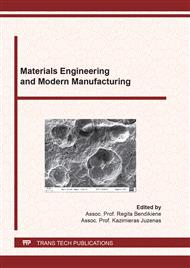[1]
International Commission on Non-Ionizing Radiation Protection (ICNIRP)1,2, Guidelines for Limiting Exposure to Electromagnetic Fields (100 kHz to 300 GHz), Health Phys. (2020) 1.
DOI: 10.1097/hp.0000000000001210
Google Scholar
[2]
European Parliament and European Council, Directive No. 2013/35/EU, of 26 June 2013, on the minimum health and safety requirements regarding the exposure of workers to the risks arising from physical agents (electromagnetic fields), Off. J. Eur. Union. 2013 (L 179) (2013) 179/1-179/21.
Google Scholar
[3]
A. Muc, Electromagnetic fields associated with transportation systems, Health Can. Tor. (2001) 52.
Google Scholar
[4]
K. H. Mild, M. Sandström, Guide Electromagnetic fields in working life. A guide to risk assessment. 1st edition (2015).
Google Scholar
[5]
European_Commission, Potential health effects of exposure to electromagnetic fields (EMF), (2015).
Google Scholar
[6]
A. A. Hossam-Eldin, W. Mokhtar, Electromagnetic Interference between Electrical Power Lines and Neighboring Pipelines, in 2008 19th International Conference on Systems Engineering, Las Vegas, NV, USA, Aug. (2008) 97-102.
DOI: 10.1109/icseng.2008.82
Google Scholar
[7]
R. M. Ansari, T. K. Hei, Effects of 60 Hz extremely low frequency magnetic fields (EMF) on radiation- and chemical-induced mutagenesis in mammalian cells, Carcinogenesis. 21 (6) (2000) 1221-1226.
DOI: 10.1093/carcin/21.6.1221
Google Scholar
[8]
A. Huss, S. Peters, R. Vermeulen, Occupational exposure to extremely low-frequency magnetic fields and the risk of ALS: A systematic review and meta-analysis, Bioelectromagnetics. 39 (2) (2018) 156-163.
DOI: 10.1002/bem.22104
Google Scholar
[9]
E. G. Kıvrak, K. K. Yurt, A. A. Kaplan, I. Alkan, G. Altun, Effects of electromagnetic fields exposure on the antioxidant defense system, J. Microsc. Ultrastruct. 5 (4) (2017) 167-176.
DOI: 10.1016/j.jmau.2017.07.003
Google Scholar
[10]
T. Koppel, I. Vilcane, Risk management of magnetic field from industrial induction heater - a case study, presented at the 16th International Scientific Conference Engineering for Rural Development. (2017).
DOI: 10.22616/erdev2017.16.n218
Google Scholar
[11]
T. Koppel, I. Vilcane, M. Ahonen, 50 Hz magnetic field affects heart rate variability – an experimental study, in 2018 EMF-Med 1st World Conference on Biomedical Applications of Electromagnetic Fields (EMF-Med). (2018) 1-2.
DOI: 10.23919/emf-med.2018.8526072
Google Scholar
[12]
J. M. Bermejo, Europe - 92% of all End of Life Tyres collected and treated in 2017. ETRMA, 2019, Accessed: Jul. 16, 2020. [Online]. Available: https://www.etrma.org/wp-content/uploads/2019/11/20191119-Europe-92-of-all-End-of-Life-Tyres-collected-and-treated-in-2017.pdf.
Google Scholar
[13]
I. Uvarova, D. Atstaja, V. Korpa, L. Avena, M. Erdmanis, End-of-life tyre recycling: going beyond to new circular business models in Latvia, presented at the 19th International Scientific Conference Engineering for Rural Development. (2020).
DOI: 10.22616/erdev.2020.19.tf435
Google Scholar
[14]
G. Ramos, F. J. Alguacil, F. A. López, The recycling of end-of-life tyres. Technological review, Rev. Metal. 47 (3) (2011) 273-284.
DOI: 10.3989/revmetalm.1052
Google Scholar
[15]
R. Ciccu, G. Costa, Recycling of secondary raw materials from end-of-life car tires, Ancona. (2012) 1115-1126.
DOI: 10.2495/sc120932
Google Scholar
[16]
V. Lapkovskis, V. Mironovs, K. Irtiseva, D. Goljandin, Study of Devulcanised Crumb Rubber-Peat Bio-Based Composite for Environmental Applications, Key Eng. Mater. 799 (2019) 148-152.
DOI: 10.4028/www.scientific.net/kem.799.148
Google Scholar
[17]
C. Bulei, M. P. Todor, T. Heput, I. Kiss, Directions for material recovery of used tires and their use in the production of new products intended for the industry of civil construction and pavements, IOP Conf. Ser. Mater. Sci. Eng. 294 (2018) 012064.
DOI: 10.1088/1757-899x/294/1/012064
Google Scholar
[18]
European Commission, The European Green Deal (COM(2019) 640 final). 2019, Accessed: Jul. 14, 2020. [Online]. Available: https://ec.europa.eu/info/sites/info/files/european-green-deal-communication_en.pdf.
Google Scholar
[19]
V. Mironovs, V. Lapkovskis, M. Kolbe, V. Zemcenkovs, Application of metallic powder materials for pulsed electromagnetic field shielding, 2014, [Online]. Available: http://www.scopus.com/inward/record.url,eid=2-s2.0-84959269569&partnerID=tZOtx3y1.
Google Scholar
[20]
V. Mironovs, V. Lapkovsky, M. Kolbe, V. Zemcenkovs, A. Shishkin, Applications of Pulsed Electromagnetic Fields in Powder Materials High Speed Forming, in 6th International Conference on High Speed Forming. (2014) 61-67.
Google Scholar
[21]
O. Ozernovs, I. Jevmenovs, Method for devulcanization of rubber and devulcanization catalyst for such purpose. Patent application PCT/IB2014/066580," WO2015083109 (A1), (2015).
Google Scholar
[22]
V. Lapkovskis, V. Mironovs, D. Goljandin, Suitability of devulcanised crumb rubber for oil spills remediation, Energy Procedia. 147 (2018) 351-357.
DOI: 10.1016/j.egypro.2018.07.103
Google Scholar
[23]
V. Lapkovskis, V. Mironovs, K. Irtiseva, D. Goljandin, A. Shishkin, Investigation of devulcanised crumb rubber milling and deagglomeration in disintegrator system, Key Eng. Mater. 800 (2019) 216-220.
DOI: 10.4028/www.scientific.net/kem.800.216
Google Scholar
[24]
S. Geetha, K. K. S. Kumar, C. R. K. Rao, M. Vijayan, D. C. Trivedi, EMI shielding: Methods and materials - A review, J. Appl. Polym. Sci. 112 (4) (2009) 2073-2086.
DOI: 10.1002/app.29812
Google Scholar
[25]
A. Sedzikowski, J. Masi, Design, and fabrication of a test apparatus and fabrication of shield materials for low frequency electromagnetic shielding, in Proceedings: Electrical Insulation Conference and Electrical Manufacturing and Coil Winding Conference, Rosemont, IL, USA. (1995) 649-654.
DOI: 10.1109/eeic.1997.651273
Google Scholar
[26]
A. Shishkin, T. Koppel, V. Mironov, I. Hussainova, J. Locs, H. Haldre, Microwave Reflectance and Transmittance Properties of Conductive Composite Materials, Energy Procedia. 113 (2017) 354-361.
DOI: 10.1016/j.egypro.2017.04.006
Google Scholar
[27]
S. Loya, Habibullakhan, Analysis of shielding effectiveness in the electric field and magnetic field and plane wave for infinite sheet metals, Int. J. Electromagn. Appl. 6 (2) (2016) 31-41.
Google Scholar
[28]
LCA Calculator - Online Sustainable Design Software. https://www.lcacalculator.com/ (accessed Jun. 20, 2020).
Google Scholar
[29]
B. Weidemam, R. Hischier, Ecoinvent data v2.2 the 2010 version of the most comprehensive and most popular public LCI database." Swiss Centre for Life Cycle Inventories, 2010, [Online]. Available: https://www.ecoinvent.org/files/201004_report_of_changes_ecoinvent_2.1_to_2.2.pdf.
Google Scholar
[30]
M. Brander, Greenhouse Gases, CO2, CO2e, and Carbon: What Do All These Terms Mean? 2012. [Online]. Available: https://ecometrica.com/assets//GHGs-CO2-CO2e-and-Carbon-What-Do-These-Mean-v2.1.pdf.
Google Scholar
[31]
P. Forster et al., Changes in Atmospheric Constituents and in Radiative Forcing,, in Climate Change 2007: The Physical Science Basis. Contribution of Working Group I to the Fourth Assessment Report of the Intergovernmental Panel on Climate Change [Solomon, S., D. Qin, M. Manning, Z. Chen, M. Marquis, K.B. Averyt, M.Tignor and H.L. Miller (eds.)]. Cambridge University Press, Cambridge, United Kingdom and New York, NY, USA. (2018) 106.
DOI: 10.1017/cbo9781107415324.019
Google Scholar


